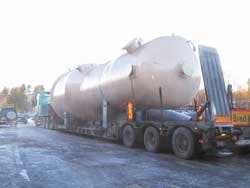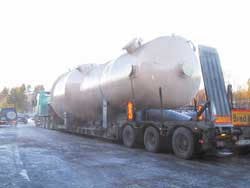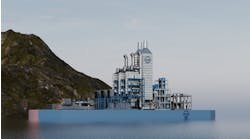Sweden: VOC recovery modules in action on Navion shuttle tankers
Allards Verkstäder has completed an order worth around £1 million for the manufacture of three Volatile Organic Compound (VOC) recovery process module components. The systems were ordered in response to recent legislation from the Norwegian Pollution Control Agency. Shuttle tankers to be equipped with the systems will include the m/t Borga, m/t Knock An and m/t Juanita, all operated by Navion. Two more systems have been ordered by Norsk Hydro for delivery this spring.
The company, based in Falun, Sweden, is partnering Kvaerner Process Systems (KPS) in Norway, which placed the order for the manufacture of absorption columns and the knock-out drums that comprise the main components of the VOC modules. The VOC recovery systems are based on technology developed by Kværner over several years. The environmental benefits of the recovery system technology were first tested on a pilot plant in 1997 with the first full-scale plant successfully installed a year later. It is claimed to be the only technology that satisfies Norwegian regulations governing the loading of oil onto shuttle tankers.
The contract was part of an exclusive agreement with KPS, which also subcontracted Allards for recent work for the Ekofisk and Grane projects.
VOC process
The absorption columns manufactured for the Kværner VOC contract measure 12 meters high by 3.5 meters in diameter. Manufac-tured from carbon steel, the columns are built to work at 15 bar. The knock-out drums are 6 meters high and 2.5 meters in diameter and will be operated at 3.5 bar. The VOC recovery process is based on the direct absorption of volatile organic compounds in a side stream of the loading oil. The oil containing the absorbed VOC is then re-mixed with the main oil-loading stream. Absorption takes place in the absorption columns in a counter current manner.
A typical system consists of an absorption column, a crude oil pump, a gas compressor and an instrumentation and control system. The equipment is assembled on a standard modular turnkey skid which is supplied ready for hook-up to the ship's system. A side stream of the loading oil, typically 5 to 10% of the total loading rate, is routed through the VOC recovery unit. The side stream is pressurized to between 5 and 15 bar before the oil enters the absorber column where it is mixed with gas being displaced from the storage tanks.
The VOC recovery process
Prior to entering the column, the emitted gas from the storage tanks is compressed. A bypass line is installed for safety in the event that the gas flow exceeds the compressor capacity. In the absorber column VOC is preferentially absorbed into the crude oil under pressure. The oil is then returned to the crude oil loading line and the remaining gas is sent to the riser, or alternatively used to power turbines on the ship.
The shuttle tankers are already in operation so each VOC unit will be assembled as a single module weighing 220 tons and measuring 23x10x4 meters. These modules will be retrofitted to the ships as they become available. The absorption columns and knock-out drums were delivered over three-week intervals to Karmoy Staal and to the Kværner Rosenberg Yard in Stavanger.
Allards Verkstäder employs 50 people and specializes in the design and manufacture of process equipment that includes shell and tube and twisted tube heat exchangers, petroleum tanks, self-cleaning strainers and various other tanks and pressure vessels. The company is a supplier of pressure vessels to Norsk Hydro and Kværner and has just begun the manufacture of three heat exchangers for the Knock Taggart FPSO offshore Nigeria. Heat exchangers for the offshore industry are designed at the Allards International office in Aberdeen.
For more information contact Mr P-O Strandin, Allards Verkstäder. Tel: +46 23 196 40, Fax: +46 23 297 71, Email: [email protected].





